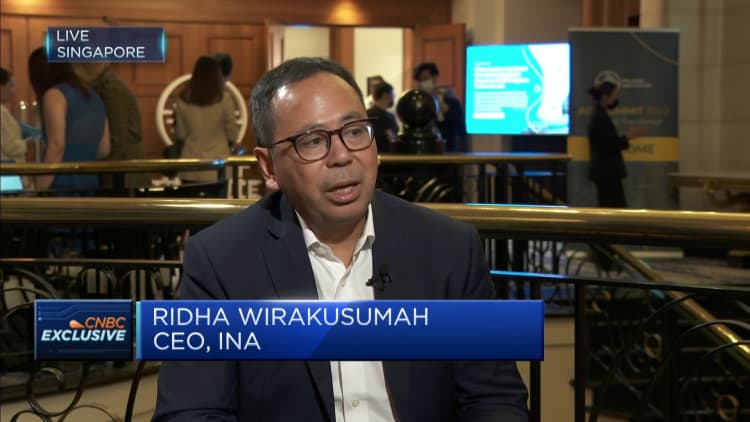A worker refuels a robotic tanker at agtech start-up eFishery at a fish farm in Subang regency, West Java, Indonesia, June 2022. The startup helps farmers optimize their processes with automatic feeders and a mobile app.
Dimas Adrian | Bloomberg | Getty Images
Indonesian tech startups are making big bucks in seafood farming. It’s no surprise – the archipelago has one of the longest coastlines in the world, with more than 18,000 islands and islets.
But there’s another reason: According to investors and startups interviewed by CNBC, a “skills gap” is preventing the industry from reaching its enormous potential.
Last year, several startups raised millions of dollars from big-name investors to fill the gap: eFishery ($90 million in Series C), Aruna ($30 million in follow-on Series A), Delos (seed expansion $8 million in Series A) and FishLog ($3.5 million Pre-A Series).
“Indonesia is the second largest producer of wild capture in the world after China. Our aquaculture production ranks third after China and India. But if we are in terms of export value, we are only 12th in the world bit,” Farid said. Naufal Aslam, co-founder and CEO of fisheries e-commerce startup Aruna. Aquaculture is the controlled farming of aquatic organisms such as fish and shellfish, especially for human consumption.
Aquaculture production and exports by country in 2020
| Aquaculture (animals, excluding algae) | Major Producing Countries in 2020 | Top exporting countries in 2020 |
| 1. | China | China |
| 2. | India | Norway |
| 3. | Indonesia | Vietnam |
| 4. | Vietnam | Chile |
| 5. | Bangladesh | India |
| Source: FAO, Statista |
“A lot of decisions are based on gut feeling or what your ancestors have done for the past 60 years,” said Guntur Mallarangeng, co-founder and chief executive of shrimp farm management company Delos.
And he’s not alone in thinking so.
“The Indonesian fishing industry has many established players who pass down traditional business practices from generation to generation,” said Yinglan Tan, founding managing partner and CEO of Insignia Ventures Partners in Singapore, which invested in FishLog.
Helping Farmers “Grow”
Indonesian fisheries need more efficient technology and better processes, Tan said.
“The only way the industry can grow is if the farmers grow. We can’t really produce more fish if the farmers don’t grow and grow their businesses,” said Gibran Huzaifah Amsi El Farizy, founder and CEO of eFishery, an aquatech start-up. company.
eFishery helps farmers optimize their processes with automated feeders and mobile apps. The automatic feeder detects the hunger level of the fish and shrimp through the movement of the fish and shrimp, thus avoiding the more common problems in the manual process: overfeeding and underfeeding.
Farizzi In 2009, while still a student, he opened his own catfish pond to supplement the family income. By the time he graduated, he weighed 76 pounds and began exploring how technology could help farmers.
He then built a prototype of the automatic feeder in 2012 and launched it in 2013.
“The cost of feeding accounts for 70%-90% of the total cost. So [automatic feeding] It can increase productivity and reduce costs,” Farizy said. He claims that the automatic feeder can reduce feeding costs by 28%.
In the case of Aruna, it helps connect small-scale aquaculture farmers in Indonesia with buyers. It claims it works with 40,000 fishermen in 170 locations.
Indonesia holds the puzzle piece to become a global leader in aquaculture and seafood production. Once we figure out how to put it all together, we should be able to become a seafood giant in the global market.
gunturmarangan
Delos Co-Founder and CEO
According to the Ocean Policy Journal of Ocean Policy Research, small-scale fisheries account for about 90 percent of fishers.
“They’re still very traditional in terms of productivity and efficiency,” Aslam said.
He claims that farmers working with Aruna are able to sell their catch for up to 50% off the price. According to a report by the Center for Impact Investing and Practice, Singapore Management University and Accenture, fishers have seen a 3- to 12-fold increase in income with Aruna.
“Farmers will produce what the market needs. This makes the supply chain more efficient and increases income for fishermen because they know the type of fish they have to catch and what they can sell at a higher price,” Aslam said. Say.
Potential to be a global leader
According to a 2016 report by market research firm Ipsos, the country ranks among the countries with the highest aquaculture production despite utilizing only 7.38% of its total aquaculture potential area.
“By properly transferring knowledge and technology of best aquaculture practices, Indonesia is well positioned to strengthen its position as one of the top aquaculture countries in the world,” the report said.
Aakash Kapoor, vice president of Sequoia Southeast Asia, which has invested in eFishery, is also “bullish” on the sector.
“Indonesia is one of the largest exporters of fish and shrimp in the world, arguably a more profitable opportunity. The government is also supporting Indonesia as an export economy in many sectors including aquaculture,” he said.
“Indonesia has the puzzle pieces to be a global leader in aquaculture and seafood production. Once we figure out how to put it all together, we should be able to become a seafood powerhouse in the global market,” Delos’ Mallarangeng said.
